AMD Phenom II X4 980 Black Edition Review
by Anand Lal Shimpi on May 2, 2011 10:42 PM ESTGaming Performance
In testing Left 4 Dead we use a custom recorded timedemo. We run on a GeForce GTX 280 at 1680 x 1050 with all quality options set to high. No AA/AF enabled.
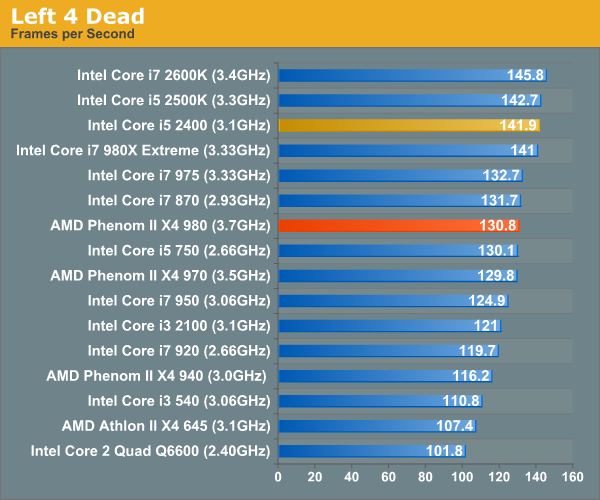
Far Cry 2 ships with several built in benchmarks. For this test we use the Playback (Action) demo at 1680 x 1050 in DX9 mode on a GTX 280. The game is set to medium defaults with performance options set to high.
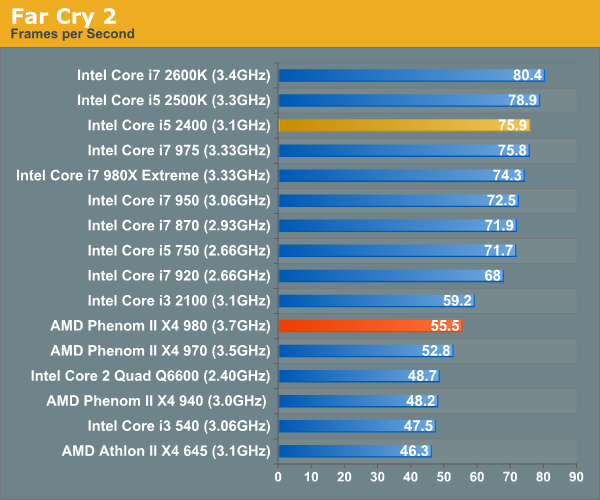
Crysis Warhead also ships with a number of built in benchmarks. Running on a GTX 280 at 1680 x 1050 we run the ambush timedemo with mainstream quality settings. Physics is set to enthusiast however to further stress the CPU.
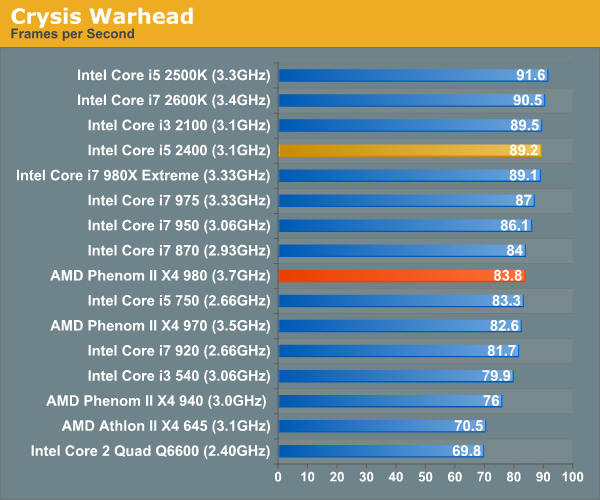
Our Dragon Age: Origins benchmark begins with a shift to the Radeon HD 5870. From this point on these games are run under our Bench refresh testbed under Windows 7 x64. Our benchmark here is the same thing we ran in our integrated graphics tests - a quick FRAPS walkthrough inside a castle. The game is run at 1680 x 1050 at high quality and texture options.
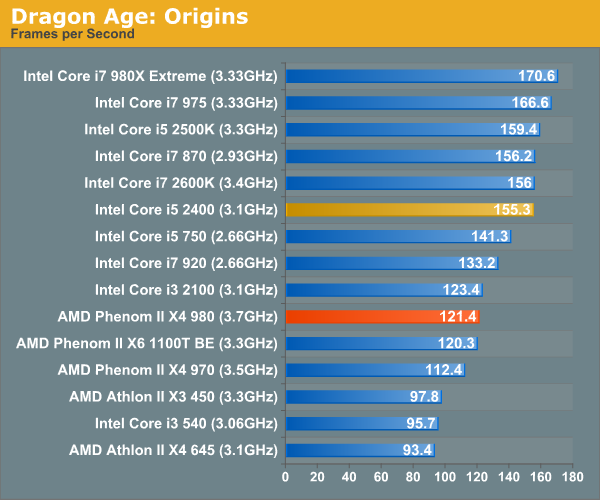
We're running Dawn of War II's internal benchmark at high quality defaults. Our GPU of choice is a Radeon HD 5870 running at 1680 x 1050.
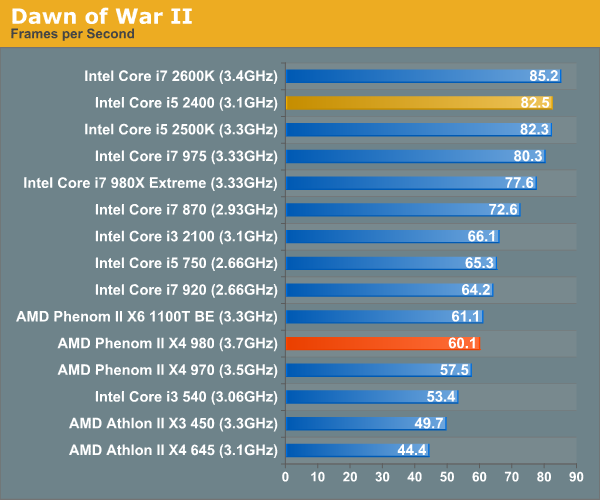
Our World of Warcraft benchmark is a manual FRAPS runthrough of a lightly populated server with no other player controlled characters around. The frame rates here are higher than you'd see in a real world scenario, but the relative comparison between CPUs is accurate.
We run on a Radeon HD 5870 at 1680 x 1050. We're using WoW's high quality defaults but with weather intensity turned down all the way.
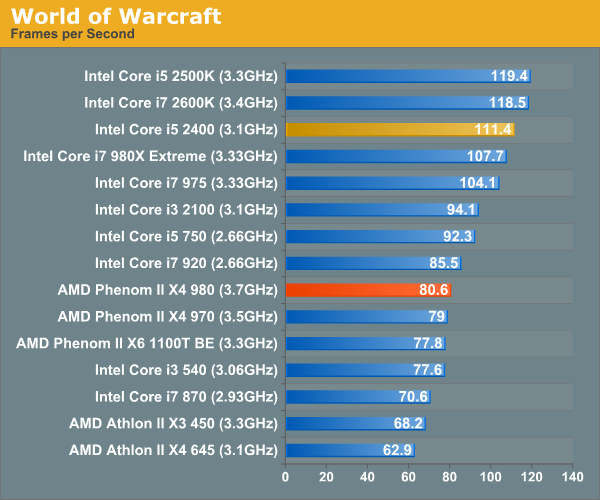
For Starcraft II we're using our heavy CPU test. This is a playback of a 3v3 match where all players gather in the middle of the map for one large, unit-heavy battle. While GPU plays a role here, we're mostly CPU bound. The Radeon HD 5870 is running at 1024 x 768 at medium quality settings to make this an even more pure CPU benchmark.

This is Civ V's built in Late GameView benchmark, the newest addition to our gaming test suite. The benchmark outputs three scores: a full render score, a no-shadow render score and a no-render score. We present the first and the last, acting as a GPU and CPU benchmark respectively.
We're running at 1680 x 1050 with all quality settings set to high. For this test we're using a brand new testbed with 8GB of memory and a GeForce GTX 580.
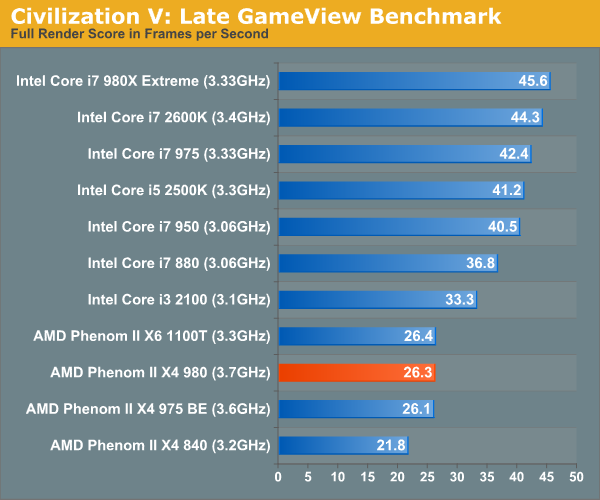
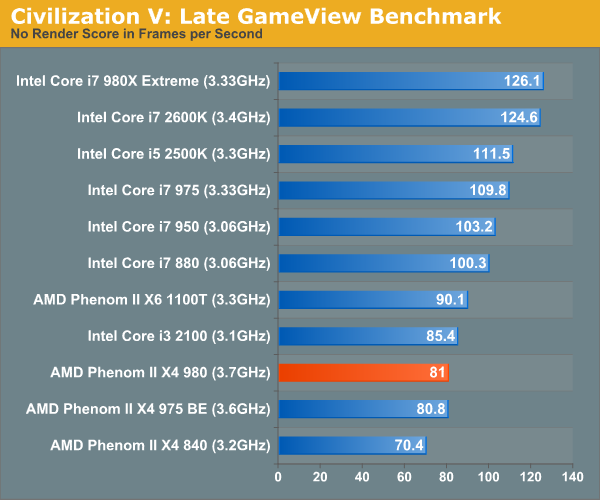










78 Comments
View All Comments
Sivar - Tuesday, May 3, 2011 - link
In "Gaming Performance", the last two charts show Core i5 frame rates which are a little on the low side.Thanks for saving the images in PNG format though. You'd be surprised how many technical authors save images which have large areas of flat color in JPG format. :)
gevorg - Tuesday, May 3, 2011 - link
How many times does AMD wants to win the worst power consumption crown?mattgmann - Tuesday, May 3, 2011 - link
Amazing that Amd's Phenom II is still clock for clock on par with the old q6600. It might have a few more refinements in coding, and a higher clock speeds, but it's raw horsepower is still on par with a 5 year old chip.AMD is two gens behind intel in performance, I don't see how BD can reasonably expect to be in the same ballpark as sandy bridge. I'm sure they'll compete in a budget based scenario, but the high end is a moon shot. With Intel's x58 replacement is in the que I just don't see AMD even sniffing a piece of the high end action.
abhaxus - Tuesday, May 3, 2011 - link
You know, I am with you. But who believed that AMD would ever have released the Athlon and beaten Intel for as long as they did? I have hope, and we all should, for our own wallet's sake. AMD's inability to beat intel is the reason my Q6600 is still a fast CPU (granted, overclocked to 3.2ghz, it isn't exactly stock).Nothing would make me happier than a fast AMD cpu to make me consider upgrading.
LancerVI - Tuesday, May 3, 2011 - link
I admit that I'm an Intel man. But I've got to say. I hope AMD pulls BD out and comes out guns blazing. My wallet could use the help!!!Intel has been able to charge whatever for quite sometime now. It needs some furious competition to help drive prices down.
...at least I hope.
mattgmann - Tuesday, May 3, 2011 - link
Don't get me wrong, I'd love it if AMD were neck and neck with intel. Competition helps my wallet and keeps high end gear in my beige box.It's just at this point in the game, BD cannot logically advance far enough past their last generation to compete with Intel's lineup. I'm sure that BD will be priced competitively and give some trouble to the low end sandy bridge chips. It won't be because their more advanced though, it'll be because the AMD chip will be a power hoggin, quad+ core with unlocked multipliers up against a lean locked down intel dual core.
DMisner - Tuesday, May 3, 2011 - link
They COULD be the high end.. if they made the move to ARM.Still though, I have faith in AMD.
aegisofrime - Tuesday, May 3, 2011 - link
Make the move to ARM, and abandon the x86 software market? Not a wise move.Unless they used some sort of dynamic translator a la Transmeta Crusoe.
Shadowmaster625 - Tuesday, May 3, 2011 - link
All they need to do is add a couple ARM cores to their existing bobcat design. Then they need to get in bed with microsoft and make sure that windows 8 properly implements schedulers that can seamlessly integrate ARM and x86 code. If AMD and microsoft both execute correctly, an 18 watt brazos chip is all we'd need for a desktop OS once the windows kernel is all ARM. Office would follow in a year. Antivirus and photo/video editing would go to the SIMDs. The x86 cores would only handle our legacy apps.extide - Wednesday, May 4, 2011 - link
Why would you EVER want to do that? Then you would have developers having to build apps that have to run on two architectures at the same time? If you want to do fixed function stuff do something like Intels Quick Sync for video, and then leave an x86 chip as an x86 chip.